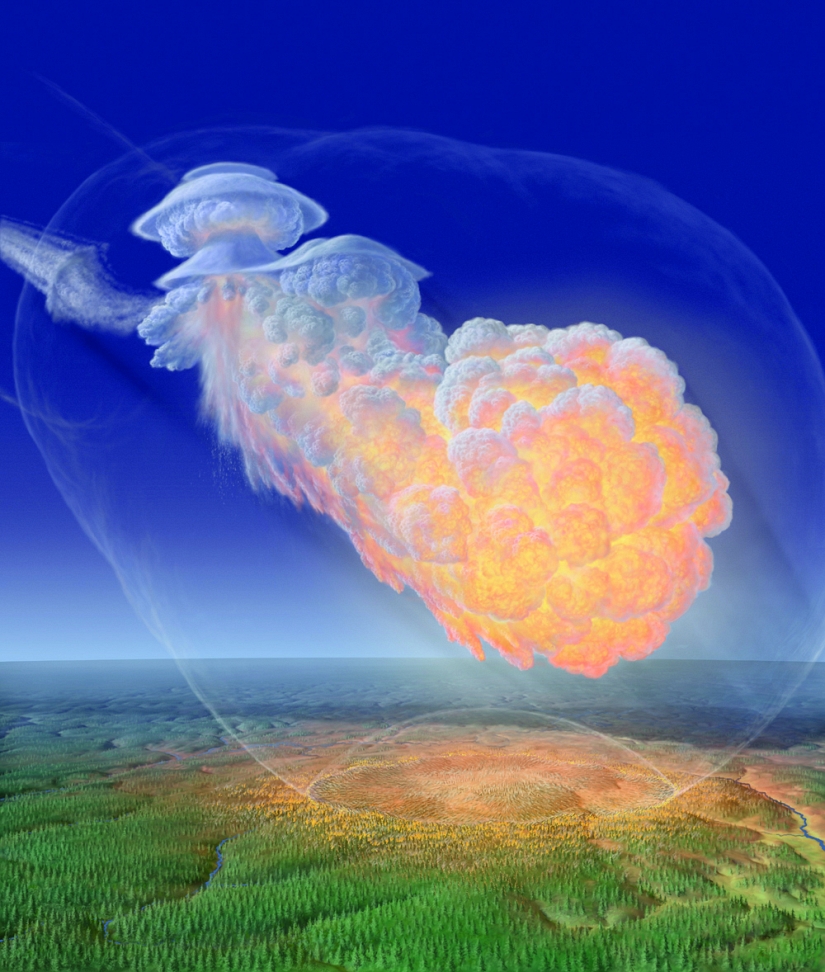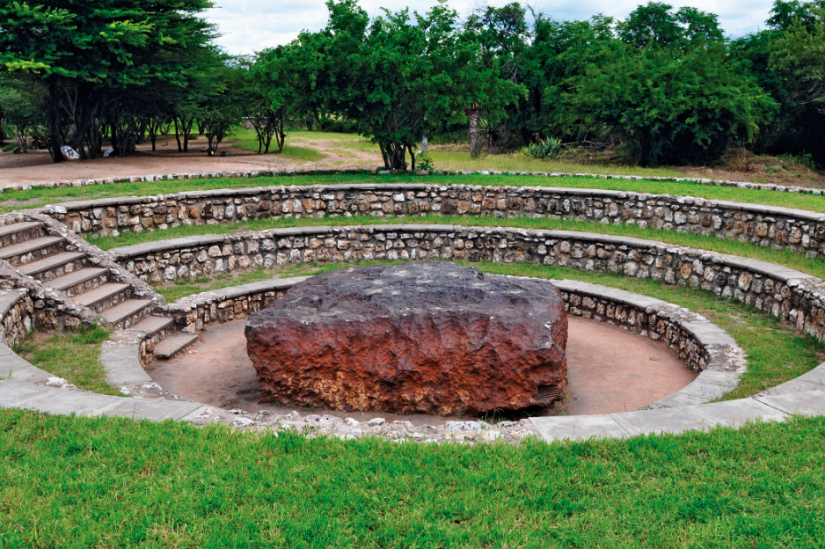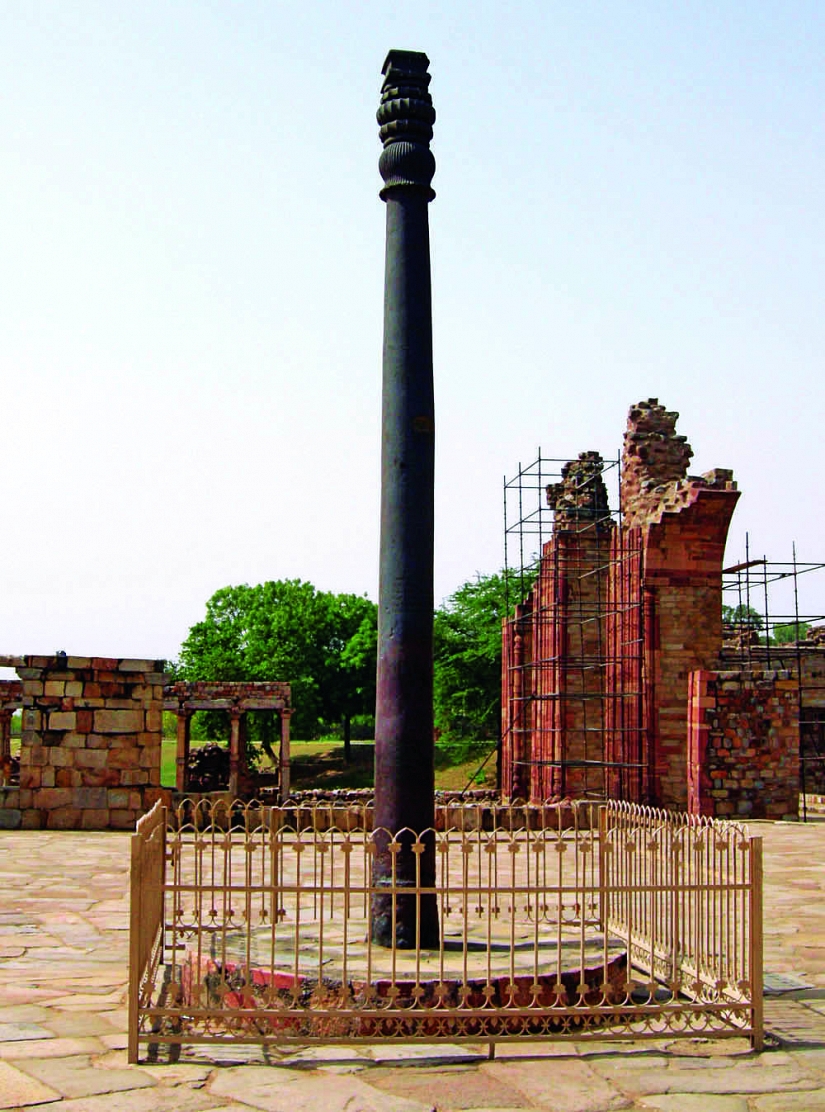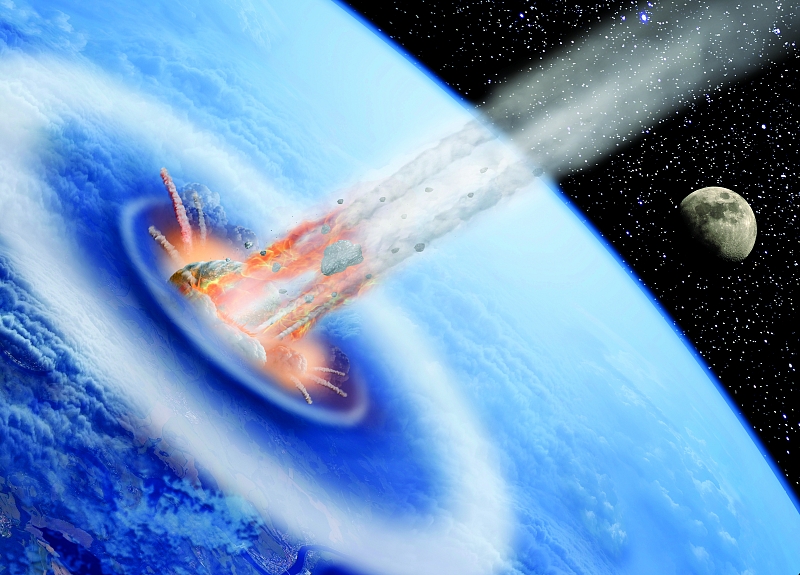Stones are falling
Every year 15 000 tons of meteorites come down to Earth; a 25kg rock landed near the city of Razgrad
It turned out that not only rocks can fall from the sky, but also iron pieces. Recently, we all got convinced by the pictures above the Russian city of Chelyabinsk, as if they were extracted from a
scientific-fantasy movie… What is the origin of these objects? Besides the eight big planets and their satellites, the Sun family contains hundreds of thousands of asteroids and comets. Multiple
smaller objects- meteoric bodies or meteorites are also going around our star.
HANGING
IN THE AIR
There are no commonly accepted limits of their size, but still we are talking about subjects with dimensions ranging from a small grain of sand, to a 10-storey apartment building. If they are
bigger, we are talking about asteroids and comet cores, and when they are smaller- cosmic dust.
The meteoric bodies spin around the Sun with a speed of tens of kilometers per second. Some of them, formed after a clash between small planets while others come from the comets, forming the
so-called meteor streams or clustering. The comet Biella, for example, fell into pieces in the far 1848. Nowadays, only the Bielidi (Andromedidi) shower reminds of it. The meteor showers
Eta-Acuaridi and Orionidi, are connected to the famous Halley's Comet.
We observe the "falling star" or "meteor" (from Greek= hanging in the air) phenomenon, when the paths of the smaller meteoric bodies cross the orbit of the Earth. That is the short lightning coming
from their burning in the atmosphere (usually at a height of 80-100 km). In fact, we don't see the actual meteoric bodies, but the shining of the excited and ionized atoms of their substance. But
what provides us with valuable information is observation - specialists define how much is the falling substance, what is the threat to spacecrafts, etc. Every year, round 15 000 tons of meteoric
substance fall around the Earth.
STEAMED STARS
The belief, that one has to wish for something when seeing a meteor, is not Bulgarian only. When the future big atom physicist Max Born went to an astronomy exam, what the famous scientist
Schwarzschild asked him was: "What do you do when you see a falling star?"
Born knew very well what to answer, but he couldn't restrain and said: "I make a wish".
The meteors, brighter than minus fourth stellar magnitude are called boids. The extremely bright ones are shining like the Sun and are observed when massive meteoric bodies dash into the
atmosphere. Usually, the main part burns out in the atmosphere, but smaller pieces can reach the Earth surface. These pieces of "celestial matter", we call meteors. Depending on the angle of
the rush, their speed can be more or less reduced by the air resistance. If the fall speed is high, an explosion might occur and then a meteor crater is formed. One of the biggest ones is the one
in Arizona, USA. Its depth is 200m, and its diameter- 1200m.

THE TUNGUSKA MIRACLE
When we hear the word "meteorite", usually the so-called Tunguska comes to mind. In the early morning of June 30th 1908m above Eastern Siberia a huge bolide, brighter than the Sun, flew over. It
was accompanied by a thunderous roar and followed by an explosion. The space new-comer exploded in the area of Podkamennaya Tunguska River. In villages, tens or hundreds of miles away, windows
were broken by the explosive wave. The explosion was also heard at a distance of 1000km. It was so massive, that it caused an earthquake.
600km away from the place of event, the motorman of the Trans-Siberian Express stopped the train, because he had assumed that some of the wagons had exploded. The explosive wave went around the
whole globe. More than 200 square kilometers of taiga had been brought down; trees' roots were pointed at the epicenter of the explosion.
But the numerous expeditions didn't found any crater, or debris. So, it's not correct to talk about the Tunguska meteorite, but a phenomenon, or if you wish, a miracle, because a lot of anomalies
and strange geophysicist phenomena have occurred. That caused many different exotic suggestions- that Earth had met with an anti-substance; that an alien ship had exploded above Podkamennaya
Tunguska, etc. The most likely explanation would be that at a height of around 10km above the Earth surface, a part of comet Encke's core had exploded. Whatever the phenomenon was, it's good it
didn't happen four hours later. Because then, as a consequence of the spinning of the Earth, the location of the explosion would have been St. Petersburg…
caused many different exotic suggestions- that Earth had met with an anti-substance; that an alien ship had exploded above Podkamennaya Tunguska, etc. The most likely explanation would be that at a
height of around 10km above the Earth surface, a part of comet Encke's core had exploded. Whatever the phenomenon was, it's good it didn't happen four hours later. Because then, as a consequence of
the spinning of the Earth, the location of the explosion would have been St. Petersburg…
caused many different exotic suggestions- that Earth had met with an anti-substance; that an alien ship had exploded above Podkamennaya Tunguska, etc. The most likely explanation would be that at a
height of around 10km above the Earth surface, a part of comet Encke's core had exploded. Whatever the phenomenon was, it's good it didn't happen four hours later. Because then, as a consequence of
the spinning of the Earth, the location of the explosion would have been St. Petersburg…
STONY IRON

Based on their content, the meteorites approaching the Earth surface are stony, iron or stony-iron (in scientific language- aerolites, siderites and siderolites). Most of them contain small
spherical or elliptic particles and are called chondrites. The stony meteorites are the most- around 93%. But the biggest "guest from space" is iron.
That is the Hoba meteorite, fallen in ancient times at the territory of current Namibia (in Southwest Africa). Its weight was 60 tons.
Meteorites have also fallen on Bulgarian territory. The fantastic Belogradchik rocks are widely known. But probably a few are the ones who have heard about the Belogradchik meteorite. Not long
ago, prof. Borislav Toshev reminded us about it. It fell near the village of Vurba on May 20th (June 1st) 1873. It was followed by a loud thunder. Its weight was almost 4 kilos and it hammered at
a depth of one meter. BAD SIGHT
Sometimes, falling objects really don't lead to victims. According to media releases on the 25th of April last year, Dimitur Gruntcharov was almost hit by a meteorite. The event took place in the
municipality of Strumyani, near Blagoevgrad, while the man was walking his dog.
Mr. Gruntcharov got away with it, but at least two other people got hurt. On November 30th 1954, a meteorite with a weight of 1.4kg broke through the roof of a house in Alabama, jumped off the
radio and fell on the sleeping Ann Hodges. Its speed had already significantly decreased, so Mrs. Hodges got away with just a small bruise.
Gerrit Blank from the German city Essen got hurt on June 5th 2009 on his way to school. A small meteorite (with the size of a pea) scratched his hand, after which, it hit the ground. Gerrit was
lucky as well. He got away with a 7.5cm burn-injury, because as a result of the high speed, the meteorite was still hot.
BG VISITORS
Here's a part of the description of the prominent meteorite scientist Walter Flight (1841-1885) about the Belogradchik meteorite:
"It is covered by a black crust, under which, we can see a meteorite with light grey and very short-grained structure; with iron grains, dispersed in the mass of the model. The microscopic
studies show that the rock mass is transparent and almost colorless, while the rock particles act on polarized light. The metal part is made of nickel and iron. (…) The silicon components (…)
show presence of olivine. (…) The meteorite shows family relation to other meteorites, such as the one from Luc, France (September 13th 1768) and others."
Unfortunately, up to date, not a single piece of the Belogradchik meteorite has been found. Fragments of it are displayed in the Museums of Natural History in Berlin, Vienna, Paris and Chicago,
in the Vatican meteorite collection and in the British Museum. The biggest piece (3040 grams) is placed at the Museum of Natural History in Budapest.
Meteorites carry the names of the places they have fallen at, therefore, in the specialized literature, the Belogradchik meteorite has been marked as Vyrba, Wirba, Urba, Vidin or Belgradjek.
The history of the Paris fragment is an interesting one. It's a present from the at the time ambassador of the Ottoman Porte in France- Saphet Pasha- the same one, who signed the San Stefano
Peace Treaty in 1878 on behalf of Sultan Abdul Hamid II.
In 1740, the biggest "Bulgarian meteorite" fell near the city of Razgrad. It weighed almost 25kg, but its current location is unknown. The other fallen on our territory meteorites are stored at
the Museum of Mineralogy, part of the Geologic-Geographic faculty of Sofia University "St. Clement of Ohrid". They are: Debnevo and Gumoshtnik (Troyan municipality, 1904, round 6kg); Silistra
(1917); Konyovo (Nova Zagora municipality, 1931); Pavel (Polski Drumbesh municipality, 1966).
THE STONE – GOD

Evidence for fallen meteorites has been around for millenniums. The first written source is from 664 B.C. A passage from the Bible can also be interpreted as evidence for a massive meteor shower:
"And when they were running from the Israelis on the side of the Vetoronska mountain, God was throwing huge stones from the sky above them (hailstorm) to the city of Azek, and they were dying:
the dead from the stones of the hailstorm were more than those who were killed by the Israelis' swords" (Joshua 10:11).
In ancient times, meteorites were often deified. Emperor Cesar Marc Aurelius Antonin (III century A.C.) declared a big black piece for a symbol of the Phoenician-Syrian God of Sun Elagabalus and
accepted the name of the divinity.
Archduke Maximilian, a future emperor of the Holy Roman Empire, considered a fallen stony meteorite in 1942 for his talisman. He ordered for it to be nailed to the wall of the church, so it
doesn't fall off it. The "Black stone" in the "Kaaba" temple in Mecca, extremely valued by Muslims, is probably also with meteorite origin.
Iron meteorites have been subject to worship as well. Talismans, amulets and weapons have been made of them. A dagger in the tomb of Tutankhamen (XIV B.C.), a present to him by the Hittites, has
surely been made of meteorite iron. As well as King Solomon's ring and Alexander the Great's crown. The rulers considered the objects to have magic powers and never parted with them. According to
the legends, the weapons and the armor of the great conquerors Attila and Tamerlane, as well as the Excalibur sword of King Arthur, also had heavenly origin. The iron crown near Delhi is 7m tall
and weighs more than six tons. It's famous with the fact that on practice, it didn't rust for 1600 years. One of the phenomenon's explanations is that it was made of meteorite iron.
FLYING
SAUCERS
The event near Chelyabinsk gave the rise of many conspiracy theories. The most exotic one is that the meteorite was exploded by a flying saucer. According to another, the
government knew about the upcoming event, but didn't warn the population so it doesn't panic. The famous Russian politician, Vladimir Jirinovski, claimed that the event has been caused by
American tests of a new weapon. But the found debris, in the area of Cherbakul Lake near Chelyabinsk show that we are talking about a stony meteorite, a normal chondrite. And the accident
revealed that we have to do everything possible to find and track not only the big asteroids, but also the smaller and closer to the Earth, objects. Something, which unfortunately, we just don't
have the technical capability to do- some of these objects are inaccessible for our current observation abilities.
A FRIEND
FROM MARS
Sometimes, meteorites also bring positive surprises. Such was the case with Allan Hills 84001. It was stony and its weight was round 2kg. It was found in Antarctica in 1984. Its chemical content
corresponded to the results obtained by the "Viking" drill, which studied Mars in 1976. It's assumed, that a huge meteorite hit the Red planet with such a shock, that the knocked out piece of
rock overcame its gravity attraction. NASA scientists found out that the meteorite contained microscopic fossils. The similar to fossil structures extremely resembled the fossils of earth
bacteria. Contamination, after falling on our planet, is impossible- there were no such fossils in the other meteors, found in Antarctica. Furthermore, the concentration of organic molecules was
increasing on the way to the core of the meteorite. If it was "infected" on Earth, it should have been the other way around.
So there are still many things in the sky that can surprise and even endanger us. And it's pure luck that up to the moment, we have avoided any serious accidents with victims, but we cannot only
rely on that. We have to responsibly approach the threatening sky…



